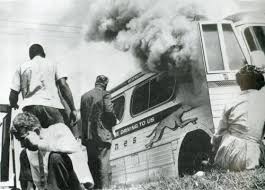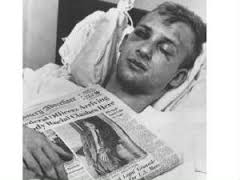
On May 14, 1961 the Freedom Riders made their way through Anniston, Alabama, where they were met with unprecedented violence by a mob of Ku Klux Klan members. Pictured above is the bus the Riders took to Anniston, which was demobilized and subsequently set ablaze with the Riders, and other unaffiliated passengers inside.
During the first year of my college career, many of my classes required outside of class time reading that we then deliberated in class discussions. Readings are a tool used by almost all teachers and professors, especially in the humanities, as scholarly works, particularly those base off of primary source evidence, provide strong insights into the topics at hand. In addition to readings, films and videos are also often times used in classrooms. The problem with films and videos, however, is that they can easily turn into time fillers that detract from potentially more productive discussion or lecture. Documentary film, though, especially when it incorporates a large amount of primary source material, such as recordings, pictures, and interviews, can be a very valuable resource for students and professors alike. Raymond Arsenault’s book Freedom Riders and the film which is based on the book are both extremely good sources for individuals who are studying the Civil Rights Movement. In his book, Arsenault does a superb job of presenting primary source evidence, such as excerpts from letters and speeches and information given in interviews with civil rights leaders, Freedom Riders, and government officials, to paint for his readers a picture of what the Civil Rights Movement looked like at the front and behind the scenes. In addition, the author provided powerful insight into the thoughts of the Kennedy brothers and the reasoning behind their decisions regarding the desegregation of public transportation. Overall, Arsenault’s book provides readers with a factual, argumentative, and emotionally effective description of the Freedom Ride Movement and makes one wonder why it took so much time and so much violence to bring an end to segregation on buses and in American society at large. The film iteration of Freedom Riders, while equally as factual as Arsenault’s book, was, by virtue of it’s ability to show visual evidence of the atrocities committed by individuals, hate groups, and public officials, much more effective at invoking an emotional response to the stories of

Pictured above is Jim Zwerg, a white Fisk University student who would become a symbol of the brutal actions taken against protestors by segregationists in the South.
the Freedom Riders. Footage and images of nonviolent protestors and reporters being brutally attacked by segregationists gives one a terrible feeling and forces one to question how a country which has always promoted democracy and equality for all could have possibly had such a dark history. However, the same images and footage also depict the heroism and undaunted courage of the Freedom Riders and give one a sense of pride in these brave activists. The print and film adaptations of Raymond Arsenault’s Freedom Riders are both superb resources for students studying the Civil Rights Movement and the emotional effect the two pieces have had on me is unchallenged by any other sources I have utilized in my study of the Civil Rights Movement.

Thank you! In preparation for the Freedom Riders’ 40th anniversary get-to-gether in Jackson, I scoured archives looking for names of Freedom Riders. I found about half. Raymond Arsenault succeeded in finding all 436 of us! So far, only one tiny error in his work has been found: he reported that Joan Trumpauer was the first Southern white female Freedom Rider, and in fact the first was Margaret Leonard, one of the New Orleans CORE Freedom Riders to Jackson. (Of the 436, only four were southern white females — Casey Hayden and I were the other two). My minor beef with the documentary, which Ray advised, is that it ends with Attorney General Robert Kennedy ending the Freedom Rides by having the ICC remove all those “white” and “colored” signs. Not true. There were 62 Freedom Rides, 7 of them after November 1 ICC ruling went into effect; one in the Atlanta Trailways station, three to McComb and three to Albany. None of those are included in the documentary. But overall, we Freedom Riders have been well documented and well served by Ray Arsenault’s decade-long work on us. And P.S. 20 of us plan to be in Montgomery next weekend for the Freedom Riders Museum’s commemoration of our 55th anniversary.